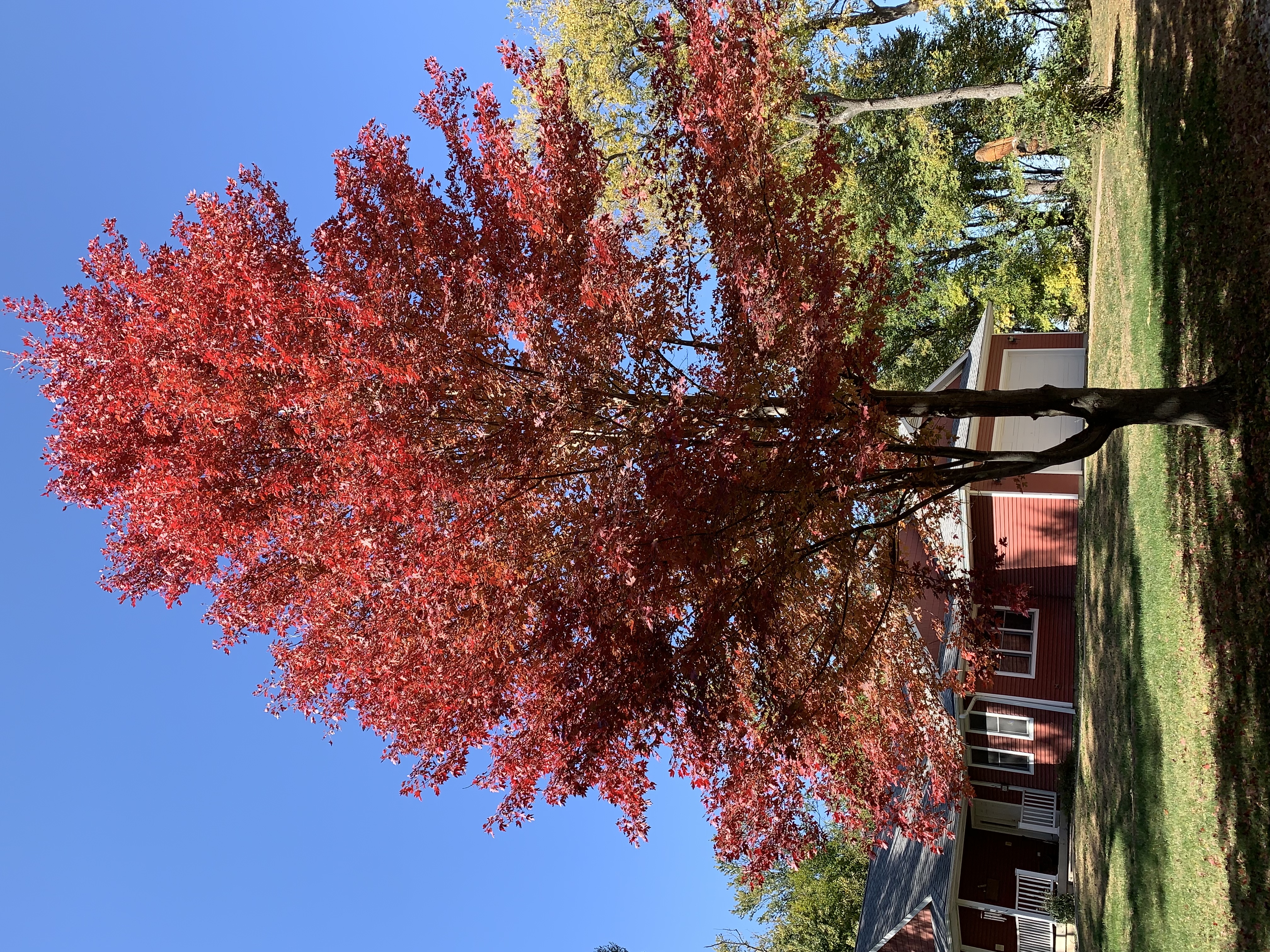Red Maple (Acer rubrum)
It’s a perfect fall for color this year. The nights have been in the 30s and 40s, the days have been sunny, and it hasn’t rained much. These are ideal conditions for our Autumn Blaze red maple to give us a spectacular show.
What makes the leaves turn red, though? Why not yellow or brown? It’s all in the leaf chemistry. During the summer, the leaves are a glossy green on top. That’s because the chlorophyll is busy at work converting sunshine into sugars and other plant foods. The leaves are a lighter silvery green on the underside.
Chlorophyll isn’t very stable. It continuously breaks down in bright sunlight, and the tree has to keep synthesizing it. This process requires warmth and more sunlight as well as inputs from the tree. When the nights cool and the day length shortens, the tree begins to wall off the leaves. The chlorophyll is done with its job and breaks down without being replaced. That leaves anthocyanin, an antioxidant that has been protecting the leaves all summer but whose red color was overridden by the chlorophyll.
Sunlight contains all the colors of the rainbow, and each color has its own wavelength. Some wavelinks (colors) are absorbed, and some are reflected depending on what the light is shining on. What we see are the colors that are reflected. We don’t see the colors that are absorbed. In this case, the chlorophyll absorbed the red and blue light from the sun, reflecting back that rich green. When the chlorophyll is gone, the red light is no longer absorbed and reflects back creating that brilliant red.
Anthocyanin is the same compound you find in red and purple flowers, fruits and vegetables like violets, apples, berries and beets. The leaves aren’t dead, though. As their stems stop communicating with the tree, they continue to work on production of more anthocyanin using the sugars still trapped in the leaves. So they stay flaming red longer even after that first hard frost brings the end of the season. What good this additional anthocyanin does for the tree is still debated. But everyone agrees that the brilliant red brings something beautiful to the autumn landscape.
After a hard freeze, the maple will shed its leaves and hunker down for the winter, where it can tolerate down to 40 degrees below zero. (Isn’t it clever that 40 degrees below zero is the same in Fahrenheit and Celsius?)
Red maples, also known as swamp maples or scarlet maples, are native to North America. They grow from Newfoundland to Louisiana and westward from the Atlantic to the prairies. Early settlers used their autumn leaves for cinnamon, brown and black dyes. In the spring, they tapped the trees for maple syrup, although the results were very poor compared to the sugar maples. The wood has been used for centuries for relatively lightweight tasks such as coat hangers and furniture. Its cousins the hard maples, which include sugar maples and black maples, produce heavier, more uniform wood. Both hard and soft maples are fairly light in color and take stain well, so they’re often used to emulate more expensive woods like mahogany.
Red maples are some of the first trees to bloom in the spring. They produce little red petalled flowers high up in the crown of the tree, so they’re easy to miss. They shed a yellow pollen that adds to the pollen count in March and April. The pollen is spread by the wind and also by a variety of bee pollinators harvesting the nectar from the little flowers. The fertilized seeds ripen in April before the leaves are fully out. They disperse over a couple of weeks in May or June, showering the yard with those floating, spinning helicopters.
Red maples are amazingly prolific. A tree that’s only two to five inches in diameter can produce 12,000 to 91,000 seeds in a single season. No wonder my gutters are full of them. They’re actually called samaras. They are reddish in color and have two papery wings that carry one dry seed in the wind. They will fly out over the meadows and fields. Some will land in favorable conditions of light and soil. Unlike trees such as walnuts, the seeds don’t need to freeze before they germinate. So, before the summer is out, they can sprout little saplings. Elk and deer used to keep these trees from taking over the landscape by eating these little upstarts. Periodic prairie fires also kept their numbers low. Today, it’s the lawn mower that does the job most of the time.
We planted our Autumn Blaze red maple as a sapling about fifteen years ago, and since then it has been home to a variety of birds, squirrels, and insects, as well as the temporary hunting blind for a feral cat. Its seeds provide food for birds and squirrels and a variety of insects such as moth caterpillars also call it home. And for a brief time in a perfect fall, it gives the world that splash of fire that helps us forget that winter is coming.
Photo by: Author

1 comment
Such a beautiful tree!